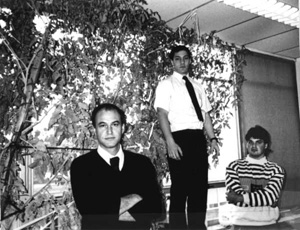 | ||
|
| ||
Paradoxes: The Green Thumb of Bradford
By Clark DeLeon
The Philadelphia Inquirer
No one who knew LA. Rotheraine when he was growing up in Burholme, PA in the late Fifties, or when he was known as "Speed" Rotheraine as a touchdown-scoring quarterback at Northeast High School in the early Sixties, or when he taught kids with disciplinary problems at Overbrook High School in the late '60s, or when he was the bouncer-doorman for seven years at Germantown's funkiest bar, Takers Cafe, during the late Seventies and early '80s, nobody who knew L.A. Rotheraine during those years would have imagined that in the 1990s he'd become the most publicized farmer in upstate Pennsylvania.
Who'd a thunk it?
But there he was on the front pages of the Bradford (PA.) Era and the Olean (N.Y.) Times Herald as well as featured twice on Buffalo's ABC network affiliate, and all because he's had a little good luck with his garden.
You'd call growing tomatoes, carrots, onions, beets and cabbages from three to five times their average size good luck, wouldn't you? Rotheraine calls such success inevitable, and he credits it all to a process called biodynamic agriculture, which in a nutshell is a system that uses everything from household garbage to nutshells to achieve the results that have created all the publicity.

For the last four years, Rotheraine has taught history at Bradford Central Christian High School, a private Catholic school in McKean County, where near the window in his classroom the single cherry tomato seed he planted in September has grown into a 8-by-14-foot plant that has spread across the room. That's Rotheraine (above left) with two of his students, Brian Douthit and Marc South, posing with the humongous plant.
How does he get these results?
"It's really quite simple," Rotheraine said. "It is the biodynamic preparations that creates the right balance of etheric energy for a healthy plant. This etheric or formative energy comes from the stars and the planets; in what science perceives as sound waves and light rays. These energies work in conjunction with the earth to create the spectacular results we've achieved in Bradford." The biodynamic science actually changes the climate in the garden.
Uh, right. Is there manure involved?
Actually, there is. It is part of the compost starter, a key element in biodynamic gardening, prepared by Margaret Selke for the Pfeiffer Foundation in Spring Valley, NY. The compost starter consists of horn manure (cow manure buried in a cow's horn), yarrow flowers, chamomile flowers, stinging nettle, oak bark, dandelion flowers and valerian flowers prepared by a biodynamic process. The compost starter is added to ordinary garbage and soil.
There's a lot more to biodynamic agriculture than meets the eye or nose. "The etheric energy is the same energy that the pre-flood Atlantean culture and the post-flood ancient cultures used to create their architectural wonders," Rotheraine said. "Not only can it solve the world's garbage problem, but it will lead humanity to the wisdom of the ancients."
Spread the word back in the old Northeast neighborhood: Speed Rotheraine's onto something big, and he's got the vegetables to prove it.
Copyright 2004 L.A. Rotheraine